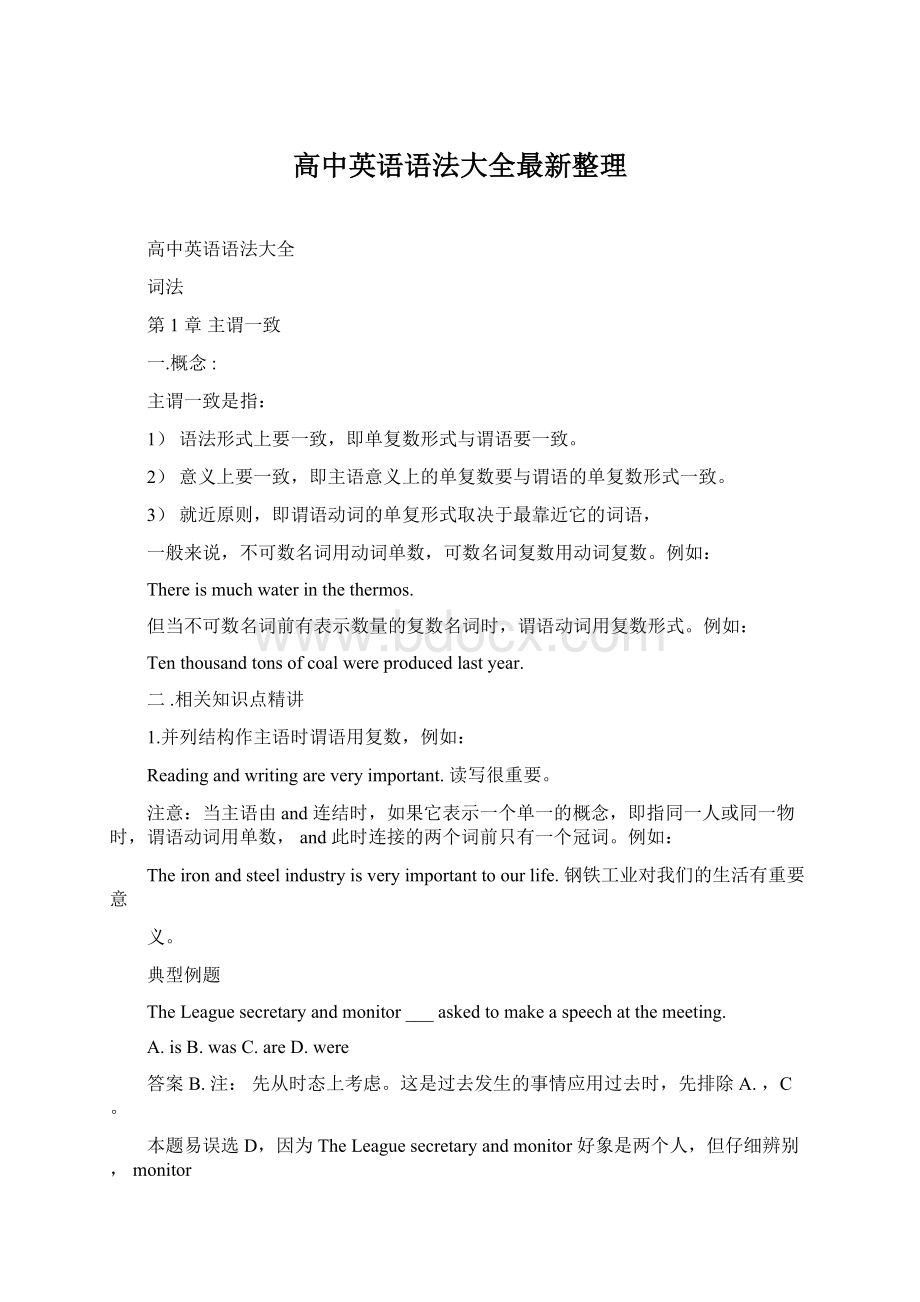 高中英语语法大全最新整理.docx
高中英语语法大全最新整理.docx
- 文档编号:7123527
- 上传时间:2023-01-20
- 格式:DOCX
- 页数:117
- 大小:105.01KB
高中英语语法大全最新整理.docx
《高中英语语法大全最新整理.docx》由会员分享,可在线阅读,更多相关《高中英语语法大全最新整理.docx(117页珍藏版)》请在冰豆网上搜索。

高中英语语法大全最新整理
高中英语语法大全
词法
第1章主谓一致
一.概念:
主谓一致是指:
1)语法形式上要一致,即单复数形式与谓语要一致。
2)意义上要一致,即主语意义上的单复数要与谓语的单复数形式一致。
3)就近原则,即谓语动词的单复形式取决于最靠近它的词语,
一般来说,不可数名词用动词单数,可数名词复数用动词复数。
例如:
Thereismuchwaterinthethermos.
但当不可数名词前有表示数量的复数名词时,谓语动词用复数形式。
例如:
Tenthousandtonsofcoalwereproducedlastyear.
二.相关知识点精讲
1.并列结构作主语时谓语用复数,例如:
Readingandwritingareveryimportant.读写很重要。
注意:
当主语由and连结时,如果它表示一个单一的概念,即指同一人或同一物时,谓语动词用单数,and此时连接的两个词前只有一个冠词。
例如:
Theironandsteelindustryisveryimportanttoourlife.钢铁工业对我们的生活有重要意
义。
典型例题
TheLeaguesecretaryandmonitor___askedtomakeaspeechatthemeeting.
A.isB.wasC.areD.were
答案B.注:
先从时态上考虑。
这是过去发生的事情应用过去时,先排除A.,C。
本题易误选D,因为TheLeaguesecretaryandmonitor好象是两个人,但仔细辨别,monitor
前没有the,在英语中,当一人兼数职时只在第一个职务前加定冠词。
后面的职务用and相
连。
这样本题主语为一个人,所以应选B。
2.主谓一致中的靠近原则
1)当therebe句型的主语是一系列事物时,谓语应与最邻近的主语保持一致。
例如:
Thereisapen,aknifeandseveralbooksonthedesk.桌上有一支笔、一把小刀和几本书。
Therearetwentyboy-studentsandtwenty-threegirl-studentsintheclass.班上有二十个男孩,
二十三个女孩。
2)当either...or...与neither...nor,连接两个主语时,谓语动词与最邻近的主语保持一致。
如果句子是由here,there引导,而主语又不止一个时,谓语通常也和最邻近的主语一致。
例如:
Eitheryouorsheistogo.不是你去,就是她去。
Hereisapen,afewenvelopsandsomepaperforyou.给你笔、信封和纸。
3.谓语动词与前面的主语一致
当主语有with,togetherwith,like,except,but,nolessthan,aswellas等词组成的短语时,谓语动词与前面的主语部分一致。
例如:
Theteachertogetherwithsomestudentsisvisitingthefactory.教师和一些学生在参观工
厂。
HeaswellasIwantstogoboating.他和我想去划船。
4.谓语需用单数的情况
1)代词each以及由every,some,no,any等构成的复合代词作主语时,或主语中含有each,
第1页共62页
every时,谓语需用单数。
例如:
Eachofushasatape-recorder.我们每人都有录音机。
Thereissomethingwrongwithmywatch.我的表坏了。
2)当主语是一本书或一条格言时,谓语动词常用单数。
例如:
TheArabianNightisabookknowntoloversofEnglish.《天方夜谭》是英语爱好者熟悉
的一本书。
3)表示金钱,时间,价格或度量衡的复合名词作主语时,通常把这些名词看作一个整体,
谓语一般用单数。
例如:
Threeweekswasallowedformakingthenecessarypreparations.用三个星期来做准备。
Tenyuanisenough.十元够了。
5.指代意义决定谓语的单复数
1)代词what,which,who,none,some,any,more,most,all等词的单复数由其指代的词的单
复数决定。
例如:
Allisright.一切顺利。
Allarepresent.人都到齐了。
2)集体名词作主语时,谓语的数要根据主语的意思来决定。
如family,audience,crew,crowd,
class,company,committee等词后,谓语动词用复数形式时强调这个集体中的各个成员,用单
数时强调该集体的整体。
例如:
Hisfamilyisn'tverylarge.他家成员不多。
Hisfamilyaremusiclovers.他家个个都是音乐爱好者。
但集合名词people,police,cattle,poultry等在任何情况下都用复数形式。
例如:
Arethereanypolicearound?
附近有警察吗?
3)有些名词,如variety,number,population,proportion,majority等有时看作单数,有时看作
复数。
例如:
Anumberof+名词复数+复数动词。
Thenumberof+名词复数+单数动词。
Anumberofbookshavelentout.
ThemajorityofthestudentslikeEnglish.
6.与后接名词或代词保持一致的情况
1)用halfof,mostof,noneof,heapsof,lotsof,plentyof等引起主语时,谓语动词通常与of
后面的名词/代词保持一致。
例如:
Mostofhismoneyisspentonbooks.他大部分的钱化在书上了。
Mostofthestudentsaretakinganactivepartinsports.大部分学生积极参与体育运动。
2)用aportionof,aseriesof,apileof,apanelof等引起主语时,谓语动词通常用单数。
例如:
Aseriesofaccidentshasbeenreported.媒体报道了一连串的事故。
Apileoflotswassetbesidethehearth.炉边有一堆木柴。
3)如manya或morethanone所修饰的短语作主语时,谓语动词多用单数形式。
但由more
than...of作主语时,动词应与其后的名词或代词保持一致。
例如:
Manyapersonhasreadthenovel.许多人读过这本书。
Morethan60percentofthestudentsarefromthecity.百分之六十多的学生来自这个城
市。
三.巩固练习
()1.Thenumberofpeopleinvited______fifty,butanumberofthem_______
absentfordifferentreasons.
A.were,wasB.was,was
C.was,wereD.were,were
第2页共62页
(
)
2.E-mail,aswellastelephones,________animportantpartindailycommunication.
A.isplaying
B.haveplayed
C.areplaying
D.play
(
)3.______
ofthelandinthatdistrict
______
coveredwithtreesandgrass.
A.Twofifth,
is
B.Twofifth,
are
C.Twofifths,
is
D.Twofifths,
are
(
)
4.
Tenminutes
______
alongtimeforonewhowaits.
A.seem
B.seems
C.seemed
D.areseemed
(
)
5.Ericistheonlyoneoftheboyswho
_____
adrivinglicense.
A.has
B.have
C.ishaving
D.arehaving'
(
)6.JoyandSorrow
_____
next-doorneighbours.
A.is
B.are
C.were
D.be
(
)
7.Inmyopinion,someofthenews
_____
unbelievable.
A.are
B.is
C.hasbeen
D.havebeen
(
)
8.When
______
theUnitedNationsfounded?
A.is
B.are
C.was
D.were
(
)
9.Everypossiblemeans
_____.
A.hastried
B.hasbeentried
C.wastried
D.weretried
(
)10.Whatshesaysanddoes
_____
nothingtodowithme.
A.was
B.were
C.has
D.have
(
)
11.There
_____
adictionaryandseveralbooksonthedesk.
A.are
B.must
C.havebeen
D.is
(
)
12.Nobody
______
seenthefilm.
It'sapity.
A.butTomandJackhave
B.exceptTomandJackhave
C.butmyfriendshas
D.butIhave
(
)
13.Noteacherandnostudent
______.
A.areadmitted
B.isadmitted
C.areadmitting
D.isadmitting
(
)
14.Allbutone______herejustnow.
A.is
B.was
C.hasbeen
D.were
(
)
15.Whenandwheretobuildthenewfactory
_____yet.
A.isnotdecided
B.arenotdecided
C.hasnotdecided
D.havenotdecided
(
)16.Thewriterandsinger
______
here.
A.is
B.are
C.were
D.do
(
)
17.AsIhaveameetingatfour,tenminutes
_____allthatIcansparetotalkwithyou.
A.are
B.was
C.is
D.were
(
)18.
InthosedaysJohnwithhisclassmates
_____
keptbusypreparingfortheexam.
A.is
B.are
C.was
D.were
(
)
19.--____
yourclothes?
--No,
mine
_____hangingoverthere.
A.Isit,is
B.Arethese,are
第3页共62页
C.Isit,areD.Arethese,is
()20.TheSmith'sfamily,which____ratheralargeone,____veryfondoftheirold
houses.
A.were,wereB.was,was
C.were,wasD.was,were
()21.Whattheteacherandthestudentswanttosay_____thateitherofthecountries
____beautiful.
A.are,areB.is,is
C.are,isD.is,are
()22.Heistheonlyoneofthestudentswho_____awinnerofscholarshipforthree
years.
A.isB.are
C.havebeenD.hasbeen
()23._____ofmybrothersarereporters.Coveringevents,meetings,orsportsmeetings
______theirduty.
A.Each,areB.Both,is
C.Neither,areD.None,is
()24.--Whatdoyouthinkofthe______ofthecoat?
--It'sratherhigh.Youcanbuyacheaperoneinthatshop.
A.valueB.costC.priceD.use
()25.--Arethetwoanswerscorrect?
--No,______correct.
A.nooneisB.botharenot
C.neitherisD.eitherisnot
()26.Thewind,togetherwithrainandfog,_____makingsailingdifficult.
A.havebeenB.was
C./D/are
四.答案
1.C2.A3.C4.B5.A6.B7.B8.C9.B10.C11.D12.
C13.B14.D15.A16.A17.C18.C19.B20.D21.B22.D23.B24.C25.C26.B
第2章动词的时态
一.概念:
时态是英语谓语动词的一种形式,表示动作发生的时间和所处的状态.英语中的时态是通过动词形式本身的变化来实现的.英语有16种时态,但中学阶段较常用的有十种:
一般现在时,一般
过去时,一般将来时,过去将来时,现在进行时,过去进行时,将来进行时,过去完成时,英在完成时和现在完成进行时.
二.相关知识点精讲
1.一般现在时的用法
1)经常性或习惯性的动作,常与表示频腮度的时间状语连用。
时间状语:
every...,
sometimes,at...,onSunday。
例如:
Ileavehomeforschoolat7everymorning.每天早上我七点离开家。
2)客观真理,客观存在,科学事实。
例如:
Theearthmovesaroundthesun.地球绕太阳转动。
ShanghailiesintheeastofChina.上海位于中国东部。
第4页共62页
3)表示格言或警句。
例如:
Pridegoesbeforeafall.骄者必败。
注意:
此用法如果出现在宾语从句中,即使主句是过去时,从句谓语也要用一般现在
时。
例:
Columbusprovedthattheearthisround.哥伦布证实了地球是圆的。
4)现在时刻的状态、能力、性格、个性。
例如:
Idon'twantsomuch.我不要那么多。
AnnwritesgoodEnglishbutdoesnotspeakwell.安英语写得不错,讲的可不行。
比较:
NowIputthesugarinthecup.把糖放入杯子。
Iamdoingmyhomeworknow.我正在做功课。
第一句用一般现在时,用于操作演示或指导说明的示范性动作,表示言行的瞬间动作。
第二句中的now是进行时的标志,表示正在进行的动作的客观状况,所以后句用一般现在时。
2.一般过去时的用法
1)在确定的过去时间里所发生的动作或存在的状态。
例如:
时间状语有:
yesterday,lastweek,
anhourago,theotherday,in1982等。
例如:
Wheredidyougojustnow?
刚才你上哪儿去了?
2)表示在过去一段时间内,经常性或习惯性的动作。
例如:
WhenIwasachild,Ioftenplayedfootballinthestreet.我是个孩子的时候,常在马路上踢足球。
WhenevertheBrownswentduringtheirvisit,theyweregivenawarmwelcome.
那时,布朗一家无论什么时候去,都受到热烈欢迎。
3)句型:
Itistimeforsb.todosth"到......时间了""该......了"。
例如:
Itistimeforyou
togotobed.你该睡觉了。
Itistimethatsb.didsth."时间已迟了""早该......了",例如Itistimeyou
wenttobed.你早该睡觉了。
would(had)rathersb.didsth.表示'宁愿某人做某事'。
例如:
I'dratheryou
cametomorrow.还是明天来吧。
4)wish,wonder,think,hope等用过去时,作试探性的询问、请求、建议等,而一般过去时
表示的动作或状态都已成为过去,现已不复存在。
例如:
Ithoughtyoumighthavesome.我
以为你想要一些。
比较:
Christinewasaninvalidallherlife.(含义:
她已不在人间。
)
Christinehasbeenaninvalidallherlife.(含义:
她现在还活着)
Mrs.DarbylivedinKentuckyforsevenyears.(含义:
达比太太已不再住在肯塔基
州。
)
Mrs.DarbyhaslivedinKentuckyforsevenyears.(含义:
现在还住在肯塔基州,
有可能指刚离去)
注意:
用过去时表示现在,表示委婉语气。
1)动词want,hope,wonder,think,intend等。
例如:
Didyouwantanythingelse?
您还要些什么吗?
Iwonderedifyoucouldhelpme.能不能帮我一下。
2)情态动词could,would。
例如:
Couldyoulendmeyourbike?
你的自行车,能借用一些吗?
3.一般将来时
1)shall用于第一人称,常被will所代替。
will在陈述句中用于各人称,在征求意见时常用于第二人称。
例如:
第5页共62页
WhichparagraphshallIreadfirst?
我先读哪一段呢?
Willyoubeathomeatseventhisevening?
今晚七点回家好吗?
2)begoingto+不定式,表示将来。
a.主语的意图,即将做某事。
例如:
Whatareyougoingtodotomorrow?
明天打算作什么呢?
b.计划,安排要发生的事。
例如:
Theplayisgoingtobeproducednextmonth。
这出戏下月开播。
c.有迹象要发生的事。
例如:
Lookatthedarkclouds,thereisgoingtobeastorm.看那
乌云,快要下雨了。
3)be+不定式表将来,按计划或正式安排将发生的事。
例如:
Wearetodisc
- 配套讲稿:
如PPT文件的首页显示word图标,表示该PPT已包含配套word讲稿。双击word图标可打开word文档。
- 特殊限制:
部分文档作品中含有的国旗、国徽等图片,仅作为作品整体效果示例展示,禁止商用。设计者仅对作品中独创性部分享有著作权。
- 关 键 词:
- 高中英语 语法 大全 最新 整理
 冰豆网所有资源均是用户自行上传分享,仅供网友学习交流,未经上传用户书面授权,请勿作他用。
冰豆网所有资源均是用户自行上传分享,仅供网友学习交流,未经上传用户书面授权,请勿作他用。


 对中国城市家庭的教育投资行为的理论和实证研究.docx
对中国城市家庭的教育投资行为的理论和实证研究.docx
